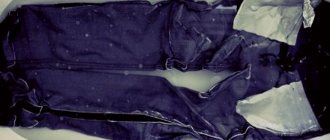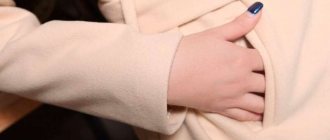What bags and backpacks cannot be washed?
Backpacks are different. Those that children wear to school are very different from both large tourist backpacks and elegant leather items favored by fashionistas. Many of them cannot be washed, while others can only be washed by hand. It depends on both the material and the design features of the backpack.
Not machine washable:
- products that have a hard, non-removable frame - both the backpack and the drum of the washing machine may be damaged;
- Items made from fabrics with water-repellent impregnation or with a special coating cannot be washed, since under the influence of detergents it will be washed off or change its properties;
- leather and eco-leather products cannot be washed; experimentation in this area can completely destroy the item - even if the outer covering survives, the lining will shrink in size, and the shape will be lost;
- Backpacks made of cordura, a nylon fabric that has a special structure and impregnation, should not be machine washed;
- Oxford fabric is made from polyester, but is not machine washable;
- the same restrictions apply to avisent made from durable nylon thread of a specific weave.
Satchels with photo prints are also not machine washable. You should not expose backpacks with spikes and other aggressive fittings to it. All holes, loose seams and other defects should be eliminated if possible.
If there were no warning labels on the product initially or they were lost during use of the backpack, you can try washing it in the machine. However, this only applies to products without a solid frame or those from which it can be removed.
Preparing for washing
How to wash a backpack in a washing machine is a whole science. First of all, it must be emptied of all its contents, not forgetting a single pocket. Then you should study the design. If the backpack has a frame, it may be possible to remove it. It is advisable to unfasten all removable parts and wash them by hand. Close all zippers.
Important! You should not load one backpack into the automatic machine. This will lead to uneven load distribution and drum beating. We need to supplement the load with a few more suitable things.
Not everything can be removed. If the model allows, it is useful to turn the product inside out. This will protect the remaining fittings, the machine drum and other things processed together with the backpack.
Turning it inside out will help get rid of any remaining debris and small items that were not noticed during cleaning. It should be washed in a special bag that performs a protective function.
Cleaning the backpack cavity
Before loading the product into the washing machine, it is checked for the presence of small things inside (coins, keys). Such measures are necessary to avoid negative impacts on the machine and the thing itself. If there are coins inside, they can oxidize in an aqueous environment, which can cause stains and rust to appear on the fabric. If there are crumbs and other debris, they need to be shaken out or cleaned with a vacuum cleaner.
What to do with stains
Fresh stains from any fabric can be removed immediately with a damp sanitary napkin. Then you should wipe the affected area with a damp cloth. However, it is not always possible to do this right away. Therefore, the cleaning method depends on what the item is stained with:
- a stain of grease on a school backpack or briefcase is common; it is recommended to sprinkle it with salt, baby powder or starch and press down lightly, and after an hour, brush off the grains and wash the entire thing or wash the affected area if it is not possible to wash the whole thing;
- An anti-grease gel designed for cleaning stoves and ovens will also help remove grease;
- ink and paste from ballpoint pens can be removed with alcohol, but you can only rub products made of leather or faux leather, having first made sure that the alcohol will not damage the material; in other cases, apply a cotton wool soaked in alcohol to the stain, then carefully remove it, running along it from the edges to the center , repeat the procedure several times;
- many stains can be removed by laundry soap; you need to soap the affected area and leave for a couple of hours, and then rinse with warm water;
- Chewing gum is afraid of frost; you can easily remove it by putting your backpack in the freezer of the refrigerator for several hours, and then simply remove the gum.
Important! Before applying any product to the entire item, it must be tested on an inconspicuous area of the fabric on the back side, as well as on the back side of the plastic parts.
We recommend:
How to wash cashmere, does it shrink after washing in the washing machine?
Machine washable
When all the preparatory work is completed, it's time to get down to business. No manufacturer's instructions will tell you how to properly wash a backpack in a washing machine. You will have to select the temperature regime, program and detergent yourself.
Selecting a washing mode
Cotton bed linen is washed at 90°C.
But a backpack is not underwear. It is sewn from a number of parts, each of which, after being in hot water, can shrink and shrink differently. Therefore, even for cotton products it is better to choose a gentle mode - no higher than 40°C. The same applies to synthetics. A higher temperature is also suitable for it, up to 60°C, but the fabric may turn pale or stained. If you wash your backpack to freshen it, a cycle without heating the water is also suitable. But an extra rinse won't hurt. It is very difficult to rinse powder off items made from thick fabrics.
It is also better to set the spin mode to gentle. To prevent any inserts from deteriorating and the seams from coming apart, it is worth setting the speed no higher than 600 rpm.
What powders should you use?
The detergent is chosen in the same way as the stain remover. It is checked on areas of the product that are not noticeable when worn.
School bags and backpacks can be washed with any soft powder or gel, even soap shavings. If a child handles the briefcase carelessly, frequent washing is inevitable. Under these conditions, you will have to say goodbye to special impregnation.
However, good expensive products made of membrane fabric should be washed only with detergents intended for this purpose. These include Nikwax, Salton Sport and Domol, produced specifically for this purpose. You can also find tools that perform 2 functions at once. They both wash and saturate the fabric of the backpack.
Handwash
Since washing a leather backpack in the usual way is strictly contraindicated, the only option is wet or dry cleaning.
How often and how it needs to be done depends on the color and texture of the product:
light ones - need more frequent cleansing than dark ones;- leather with the effect of aging – are more resistant to pollution;
- embossed leather - washing with warm water and cleaning with a hard brush is contraindicated;
- products with lacquered and suede inserts are especially sensitive to negative external factors and require a careful approach.
To care for a leather backpack, you need to get a special kit:
- soft bristle brush;
- wet and dry wipes;
- mild detergents intended for leather products;
- sponges;
- various impregnations and paints for leather.
Having chosen a particular leather cleaner, you should first conduct a compatibility test: a small amount is applied to the material of the backpack. If it does not lose its original qualities, you can proceed further.
First of all, take out the contents and turn the lining inside out, clean it with a sponge soaked in soapy water . Upon completion of the procedure, wipe the inside of the backpack with a solution of ammonia, liquid soap and water (1:1:5).
If this does not help eliminate the contaminants on the material and an unpleasant odor remains, try another method:
- Mix soda with water and treat problem areas with the resulting slurry.
- After 15-20 minutes, the mixture is washed off with warm water.
Fresh stains can be easily wiped off with alcohol or vodka . And small debris accumulated inside is removed using a vacuum cleaner.
On the outside, they wipe the creases, seams and handles with ammonia, and then go over the rest of the area. After 5-10 minutes, wipe with a solution prepared on the basis of liquid soap (dishwashing detergent).
Leather products are extremely susceptible to excess moisture. Therefore, all manipulations are carried out quickly so that water is not absorbed into the material .
If it was not possible to avoid getting very wet, then fill the backpack with crumpled newspapers (they absorb moisture well).
Cleaning backpacks depending on the color and type of material:
- Black or dark shades . Use natural ground coffee. Make a paste: 1 tsp. and some water. Apply the mixture to the surface in a circular motion and immediately upon completion wash off with a wet cloth. An alternative to coffee is glycerin.
- Light or white .
Cow's milk shows good results. It cleanses and softens the skin. It is preheated slightly and with the help of a cotton swab they begin to treat the surface of the product. You can mix beaten egg whites with milk. Lemon juice or laundry soap dissolved in warm water can easily cope with minor stains and gray deposits. - Colored. To prevent the design from fading, use soft sponges or cloth napkins when cleaning. Soapy water is suitable as a cleaning agent. And greasy deposits are effectively washed off with dishwashing detergent. It is recommended to clean the red backpack with talcum powder.
- Made from patent and smooth leather . Patented and smooth leather is wiped with a damp cloth and rubbed with a velvety cloth. Another option is to use onions, cut in half, for peeling. For protection, the leather is coated with special products sold in shoe departments.
It is unacceptable to clean varnish products with alcohol-containing compounds. They lose their shine. Skin creams that promote the formation of streaks are not suitable.
Rules for drying a backpack after machine washing
It is better to dry a washed backpack in natural conditions. To do this, it is useful to secure it on hangers and hang it on the balcony. Pockets must be opened and zippers unzipped so that the inside dries faster.
If it is not possible to place it outside, you will have to dry it at home. You can remove it only after it has completely dried, otherwise an unpleasant odor will appear inside, and sometimes mold will form.
Important! Do not dry in a dryer or washing machine with the appropriate function. The item may lose its shape and be hopelessly damaged.
Fashionable and comfortable backpacks and satchels will last for years if you care for them correctly. Even a school bag can survive more than one school year.
Preparation
Hooks and straps can damage the washing machine, so they must be unfastened. Other hard elements of the product are removed. For the same reason, if possible, it is better to remove plastic carabiners and latches for manual cleaning. The protruding threads on pockets, zippers, and fastenings are cut off so that they do not spoil the item during processing by catching on other parts.
Before starting the device, each contaminated area is wiped with a wet cloth. Dried dirt can cause stains on your bag when exposed to water. If there are heavily soiled areas (stains), they are removed before washing. Before the procedure, you should treat the most contaminated areas with a stain remover or laundry soap, rub with a brush and rinse. The inside of the product may also contain stains (ink, drinks). In case of heavy contamination, the bag is soaked in warm water for an hour and a half. You just need to add soap (can be grated with shavings) and baking soda.
When machine washed, the pockets and snake sections wash much less well.











